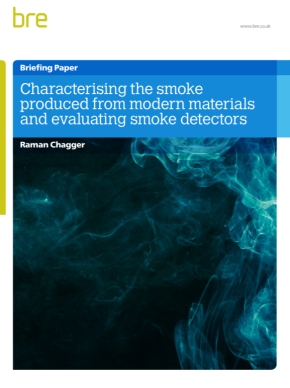Characterising smoke from modern materials and evaluating smoke detectors
Characterising smoke from modern materials and evaluating smoke detectors was written by Raman Chagger and published by BRE in 2014.
The object of this research was to investigate the smoke profiles generated in fire tests specified in the EN 54-7 (commercial) and EN 14604 (domestic) smoke detector standards, and to compare them with smoke produced from burning or smouldering materials commonly found in today‘s service environment.
The four test fires used to assess smoke detectors were developed in the 1980s and represent a broad range of smoke types expected in commercial and domestic environments at the time. However, the materials used in modern homes have changed significantly in recent decades. This research investigated whether smoke detectors could respond to the smoke produced from those new materials during a fire.
The smoke characteristics for a range of new materials were measured and compared with the four test fires. The performance of approved ionisation and optical smoke detectors to the smoke produced from these materials was also assessed. It was confirmed that both ionisation and optical smoke detectors are attuned to detecting certain types of fires and that existing standards remain suitable for assessing these technologies.
The knowledge gained from this study enabled more challenging test fires to be developed that were used during multi-sensor research work.
The contents of the briefing paper are:
- Abstract.
- Introduction.
- Background.
- The current test fires.
- Methodology.
- Results.
- Analysis.
- Summary of results.
- Conclusions and recommendations for further research.
- References.
- Acknowledgements.
You can download the briefing paper at: https://files.bregroup.com/research/Test-Fires-Characterisation_2014-November.pdf
[edit] Related articles on Designing Buildings Wiki
Featured articles and news
Retrofit 25 – What's Stopping Us?
Exhibition Opens at The Building Centre.
Types of work to existing buildings
A simple circular economy wiki breakdown with further links.
A threat to the creativity that makes London special.
How can digital twins boost profitability within construction?
The smart construction dashboard, as-built data and site changes forming an accurate digital twin.
Unlocking surplus public defence land and more to speed up the delivery of housing.
The Planning and Infrastructure bill oulined
With reactions from IHBC and others on its potential impacts.
Farnborough College Unveils its Half-house for Sustainable Construction Training.
Spring Statement 2025 with reactions from industry
Confirming previously announced funding, and welfare changes amid adjusted growth forecast.
Scottish Government responds to Grenfell report
As fund for unsafe cladding assessments is launched.
CLC and BSR process map for HRB approvals
One of the initial outputs of their weekly BSR meetings.
Architects Academy at an insulation manufacturing facility
Programme of technical engagement for aspiring designers.
Building Safety Levy technical consultation response
Details of the planned levy now due in 2026.
Great British Energy install solar on school and NHS sites
200 schools and 200 NHS sites to get solar systems, as first project of the newly formed government initiative.
600 million for 60,000 more skilled construction workers
Announced by Treasury ahead of the Spring Statement.
The restoration of the novelist’s birthplace in Eastwood.
Life Critical Fire Safety External Wall System LCFS EWS
Breaking down what is meant by this now often used term.
PAC report on the Remediation of Dangerous Cladding
Recommendations on workforce, transparency, support, insurance, funding, fraud and mismanagement.
New towns, expanded settlements and housing delivery
Modular inquiry asks if new towns and expanded settlements are an effective means of delivering housing.


























